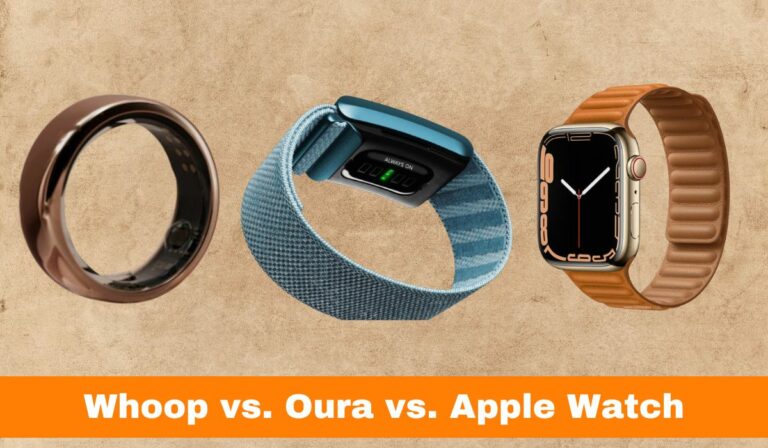Whoop, Oura ring, and Apple Watch are the best fitness trackers on the market. If you’re starting your fitness tracking journey, you might need clarification about which fitness monitoring device to use. Our Whoop vs. Oura vs. Apple watch comparison will help you out!
Choosing from these fitness wearables is a tricky part as it focuses solely on the goals you might have. These health and fitness tracking devices offer different features to aid your ambitions!
In short, Oura or Whoop, and Apple Watch offer intent-driven attributes. So, let’s compare these fitness trackers in-depth to help you out!
Whoop vs. Oura vs. Apple Watch: Feature Breakdown
1- Activity Tracking or Heart Rate Monitoring
Whoop
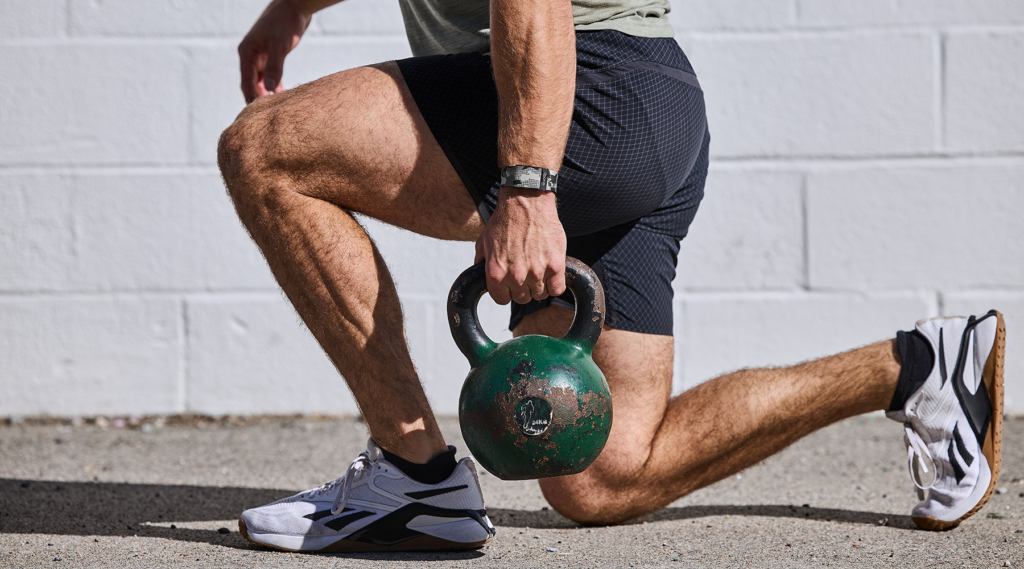
Whoop activity tracking depends on your heartbeat state and heart rate variability (HRV). So, the Whoop band determines the activity you’re engaging in based on your heart rate state, and it detects heart rate through photoplethysmography sensors.
The heart rate varies greatly depending on your body’s condition. As when you are asleep, your heart is in a resting heart rate state. It changes as you wake up, which you can with a Whoop vibrational alarm and engage in a different activity.
Whoop is the most accurate fitness wearable as its heart rate monitoring matrix is most in compliance with Electro Cardiogram (ECG). ElectroCardiogram (ECG) is the benchmark for calibrating the variability in heart rate, and being able to match it is no small feat.
Whoop does a great job tracking High-intensity Interval Training (HIIT), Yoga, Pilates, Gym workouts, Cross fit, and much more.
Oura Ring
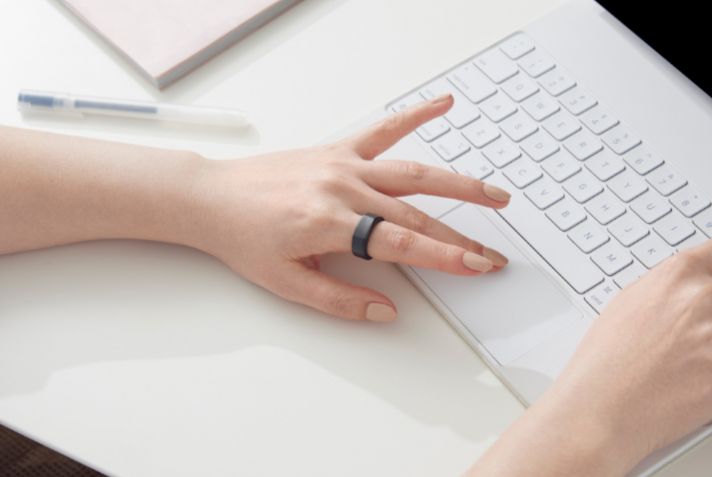
On the other hand, even though Oura Ring does provide activity data, it is not at par with Whoop. This fitness tracking ring’s fitness workout tracking ability is quite simple for athletes.
The Oura ring’s activity monitoring capabilities could be more varied and advanced. On Oura Ring App, you can get insights into your performance data under the activity tab.
Recovery time, inactivity, and daily activity levels contribute to your daily activity scores. These scores are recognizable by scrolling over the app on your smartphone. The activity scores given by Oura Ring are from 1-100 as they depend on activity contributors.
This fitness wearable device suggests 80 and above 80 scores as acceptable. Below 80, this fitness ring hints at how to improve your score.
The activity tracking domain is where Oura Ring needs a lot of improvement. This fitness ring tracks heart rate activity in general endeavors such as walking and running, even though it claims to track 50 different activities.
Apple Watch
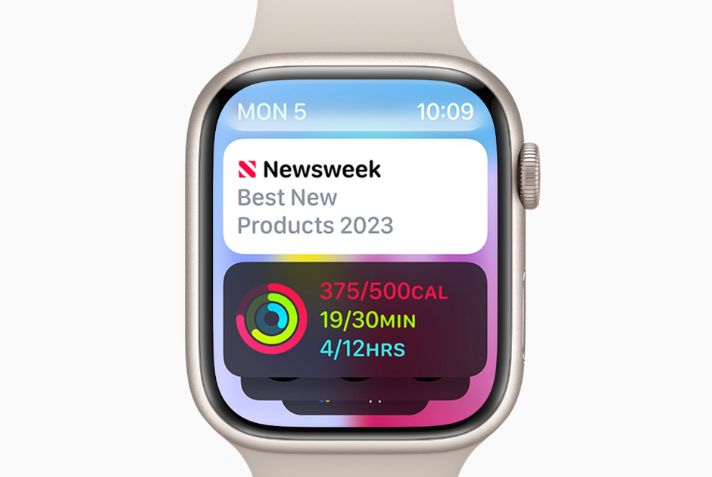
Regarding heart rate and activity tracking, Apple watches dominate fitness trackers.
They monitor your heart rate through their photoplethysmography sensors or PPG. Apple watches have used this heart rate tracking method since its inception.
You can view real-time insights into your heart rate on the watch’s screen, which is unavailable in Whoop and Oura Ring. So the on-screen heart rate tracking is one of the significant advantages of the Apple watch that I enjoy.
However, if you want to access this matrix in detail, you should use the native app on your iPhone.
Apple watches also automatically detect your activities like walk, run, cycling, dance, hiking, core training, etc.. You can view the insights of your activities on the Apple Watch app.
2- Stress and Strain Tracking
Whoop
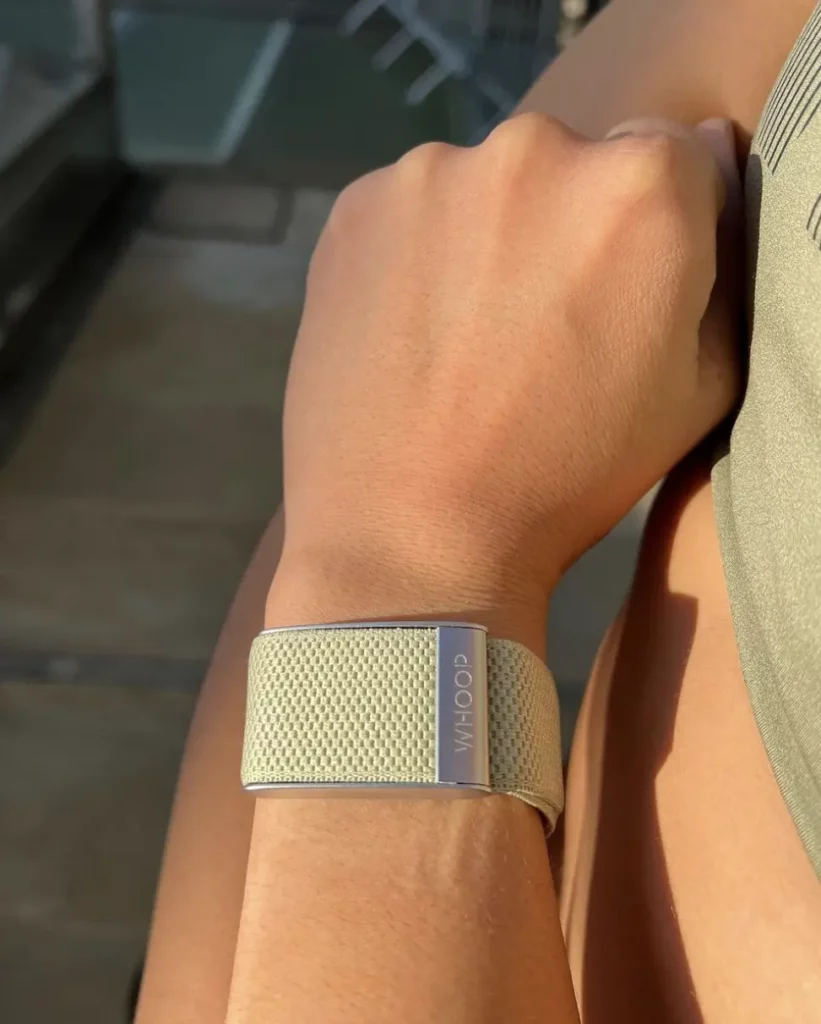
Whoop provides recovery, strain, and sleep matrix data to improve your health and fitness.
Whoop employs electrodermal activity (EDA) and ambient temperature to calibrate strain. Strain is mental and physical stress on your body. So, it determines the combined stress level in your body.
Whoop measures strain and has a specialized feature of strain coach to help you improve your health and fitness.
Whoop designates the strain level of the body based on the activities you had engaged in the previous day. Based on previous-day variables, this fitness tracker guides how much strain your body can handle.
Oura Ring
Oura ring does trail your body strain levels quite efficiently. The strain score it provides depends on your sleep and heart rate variability (HRV).
Oura ring’s heart rate variability matrix caters to time asleep and how long it takes to fall asleep, i.e., sleep latency, and restfulness. These variables affect heart rate, which can, in turn, impact your body strain score.
The body strain score directly influences the readiness of your body to undertake any physical or mental exercise. So, the less stressed you’re, the better you score in the strain matrix, and the more recovered you will be for the next training session.
Apple Watch
Apple Watch confers stress and strain data but could also be more efficient in this territory. One reason for this is that the Apple watch has the least battery life among all the three fitness wearables under discussion.
This fitness tracker relies heavily on specific app inside, even for stress monitoring. Apple Watch does measure stress levels in the user’s body quite accurately, but it is not on par with other fitness wearables.
The Apple Watch uses a heart rate sensor to compute stress in the user’s body.
In short, Whoop and Oura Ring are the best fitness trackers if you need one that tracks stress and strain proficiently.
3- Calorie Tracking
Whoop
For a fitness enthusiast or fitness expert, calorie tracking is one of the major factors to consider in your journey. Whoop provides quite accurate calorie data among all wrist-worn fitness trackers.
The calorie tracking sensors of Whoop deploy an accelerometer and photoplethysmography sensors to measure calories quite efficiently.
Oura Ring and Apple Watch
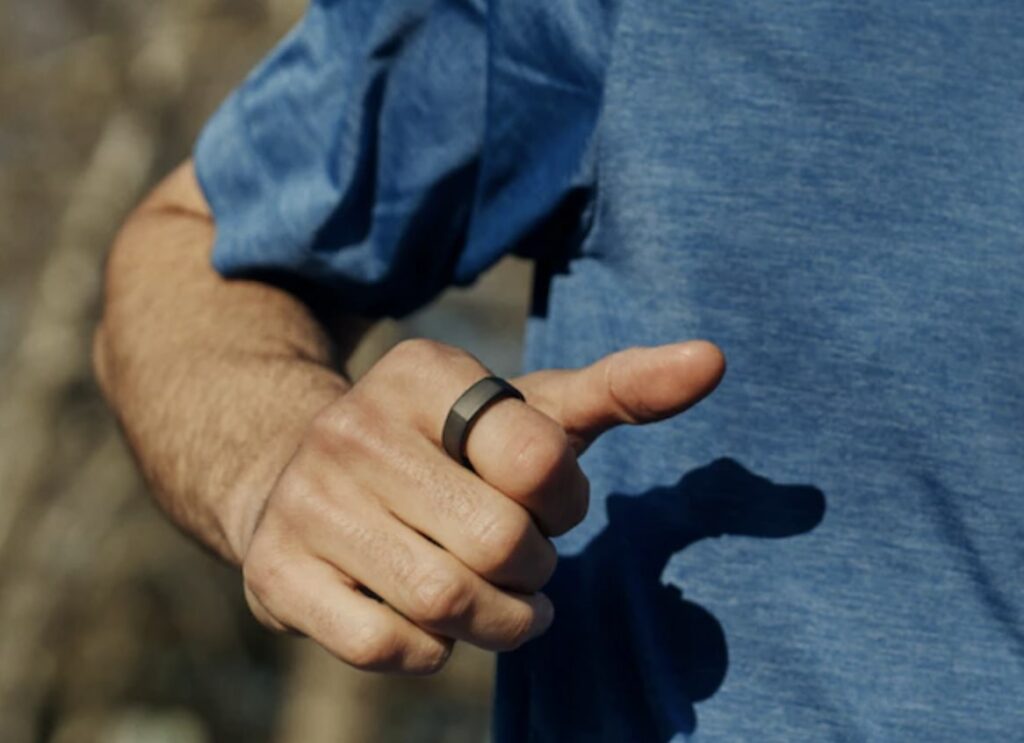
The calorie tracking in Oura Ring also relies upon its photoplethysmography sensor. Like Whoop, this health and fitness wearable is quite competent in tracking calories burnt.
Oura Tracks calories burned based on the steps you take. The Apple Watch also tracks calories based on steps, but your activity steps are always less on the Apple watch. Let us clarify it with an example!
According to Oura, if you took 9000 steps and burned 494 calories, then the Apple watch might suggest the steps and calories as 7000 and 594, respectively.
So, there is always at least a difference of 100 calories in the calibrations of the Apple Watch and the Oura ring.
Briefly, if you’re up for calorie tracking to achieve your fitness ambitions better, then Whoop and Oura are the best fitness wearables to go for.
4- SPO2, Sleep and Recovery Tracking
Whoop
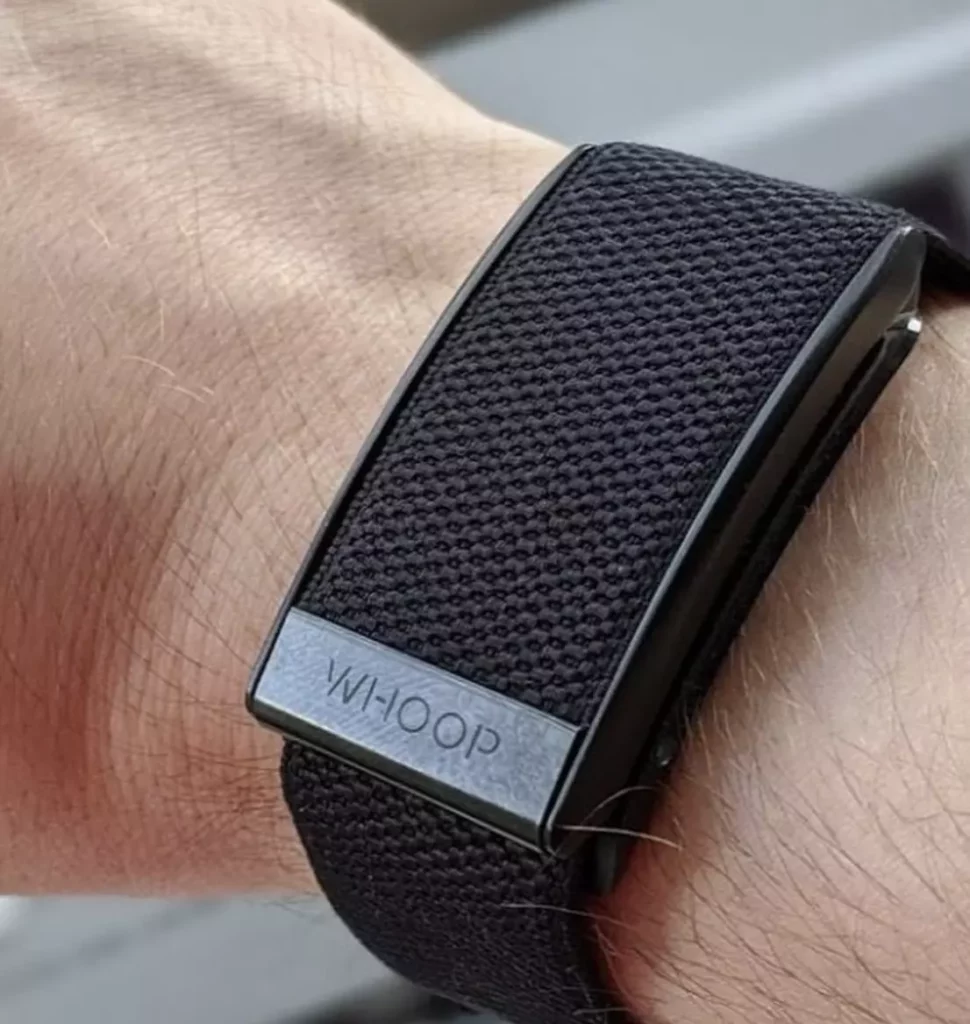
Like the Apple Watch and Oura ring, Whoop measures blood oxygen or SPO2 levels to regulate your fitness routine. When it comes to sleep monitoring, it offers quite advanced data.
In addition to SPO2 levels, the strain matrix plays a vital role in recovery analysis for this fitness tracker.
Whoop specifies your recovery in colors. “Green” color represents that your body recovered well, “Yellow” means you’re doing good, and “Red” means your body needs proper rest.
Recovery and sleep go hand in hand, and Whoop does provide sleep data, but it needs upgradation as it could be more efficient than Oura Ring. Whoop uses ambient temperature to gauge body recovery after sleep.
As ambient temperature differs greatly from your body temperature, it is not quite right to use it for sleep analysis. So, ambient temperature can be far off your body temperature resulting in false sleep and recovery data.
Oura Ring
Unlike Whoop, Oura Ring is among the best sleep trackers around the globe. Oura sleep matrix calculations match the absolute standard of sleep lab tests. So, this fitness tracking ring uses one of the most precise sleep and recovery measuring technologies.
The sleep and recovery data rely on the Oura ring’s heart rate, temperature, and activity data. You might score well, but a low score means you must take it easy and re-evaluate your plan for this day.
Oura Ring scales your sleep performance based on sleep stage analysis, and it evaluates your sleep quantity and quality in each stage of sleep rather thoroughly.
This sleep-tracking ring monitors the stages of Rapid Eye Movement (REM) and deep Sleep. But both Whoop and Apple Watch also keep these sleep stages in check.
So, what makes Oura Ring the best sleep and recovery tracker among the three fitness wearables? It appraises “timings” in sleep which other fitness trackers don’t offer. This timing represents the core of your total sleep between midnight and 3 AM.
Oura mentions recovery through the recovery index and speculates blood oxygen or SPO2 levels. How different red and infrared LED lights reflect in your body determines your blood oxygen level, and your ring sends these signals.
Oura ring only offers a little sensing of blood oxygen levels, which is less efficient than the inference on sleep sessions lasting longer than 3 hours. In addition to the oxygen level matrix, Oura does offer period prediction for females.
Apple Watch
Apple Watch sleep tracking is below the bar compared to Whoop and Oura Ring.
To begin with, if you’re obsessed with cutting-edge sleep data, the Apple Watch is highly inapt for your needs as the sleep data it imparts is quite plain.
However, you can use additional apps inside this device for hands-on, in-depth sleep tracking data in the native app.
On top of not being so advanced, Apple Watch sleep tracking requires a bare minimum of 4 hours of sleep. So, it would mean no sleep data if you slept less than 4 hours.
Apple Watch contains a workout app that measures your recovery as well. But it assumes your body is 100% recovered each day you wake up. Yep! You heard that right!
So, even if you had the most intense workout last day, Apple Watch would suggest that you’re 100% recovered. Apple watch is quite good in SPO2 matrix provision due to its unbiased nature, unlike most other pulse oximeters.
To summarize, Oura Ring is the best choice for the sleep and recovery monitoring as it offers reliable and Hi-tech data. But for blood oxygen level guesstimates, either Apple Watch or Whoop would suit you more.
6- Waterproof Nature and Display
To begin with, neither Whoop, Oura ring nor the Apple watch is completely waterproof. However, these fitness trackers are water-resistant up to a certain depth.
These fitness wearables can resist water under a certain depth, so they are waterproof to a certain degree.
Whoop is waterproof up to 10 meters or 32 feet, and the Apple watch is waterproof to 100 meters or 328 feet. Like the Apple Watch, the Oura ring is also waterproof, as far as 100 meters or 328 feet.
In addition to its waterproof nature, the Apple Watch is the only fitness-tracking device among these three that offers a productive display as it is based on smartwatch technology.
So, the Apple watch is the most competent if you want to display water resistance in your fitness tracker.
7- Design, Battery Life, and Pricing
Whoop is the craftiest designed wrist wearable amongst all wrist-worn fitness trackers, as its design is like a wristband. In addition to its slick design, the Whoop battery lasts around 5 days.
Whoop is subscription based, so there is no upfront payment for the Whoop band. However, the most basic membership fee costs around 30 USD monthly.
On the other hand, Oura ring, as the name implies, is a ring-based fitness tracker, and it packs a punch in battery life as its charging lasts for about 7 days at maximum. The subscription fee of Oura also varies, but the cost of the ring itself is 299 USD.
Apple Watch possesses a smartwatch style with the least battery life of 18-20 hours among these three fitness trackers.
This low battery life of the Apple watch is quite understandable as it also offers a display screen. Apple watch quotes around 399 USD.
So, regarding design and battery life, that’s a personal preference, but the Oura ring is superior regarding charging.
Comparison Table for Whoop vs. Oura vs. Apple Watch
| Characteristics | Whoop | Oura Ring | Apple Watch Series 7/8 |
| Activity and Heart Rate Tracking | Yes (Best) | Yes | Yes |
| Strain and SPO2 | Yes | Yes | Yes |
| Calorie Tracking | Yes | Yes | Yes |
| Sleep and Recovery Tracking | Yes | Yes (Best) | Yes |
| Waterproof or Water resistance | 10m or 32feet | 100m or 328 feet | 100m or 328 feet |
| Battery life and Display | 5 days (No Display) | 7 days (No Display) | 18-20 hours (Display available) |
| Price | 30 USD monthly (most economical) | 299 USD | 399 USD |
Wrap Up
In a nutshell, picking from Whoop, Oura, and Apple Watch relies entirely upon your preferences and goals. Each fitness tracker has a lot of fortes and flaws as well.
If you want the best fitness activity or performance tracker, go with Whoop, as it is the most suitable for fitness enthusiasts, experts, and professionals.
If your focus is sleep and recovery tracking, associate yourself with the Oura ring, which suits you best. But, if you want a wearable fitness device with a display, the Apple watch series is the best fit for you.
Choosing the best among Whoop, Oura ring, and Apple Watch is tricky and relies entirely upon your preferences. We have given our best Whoop vs. Oura vs. Apple Watch comparison to help you to decide for yourself.

